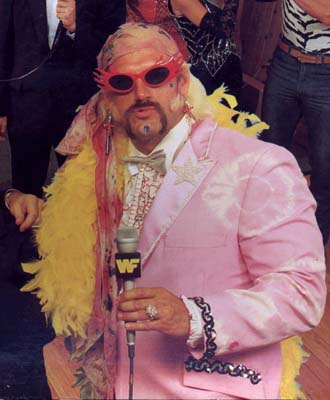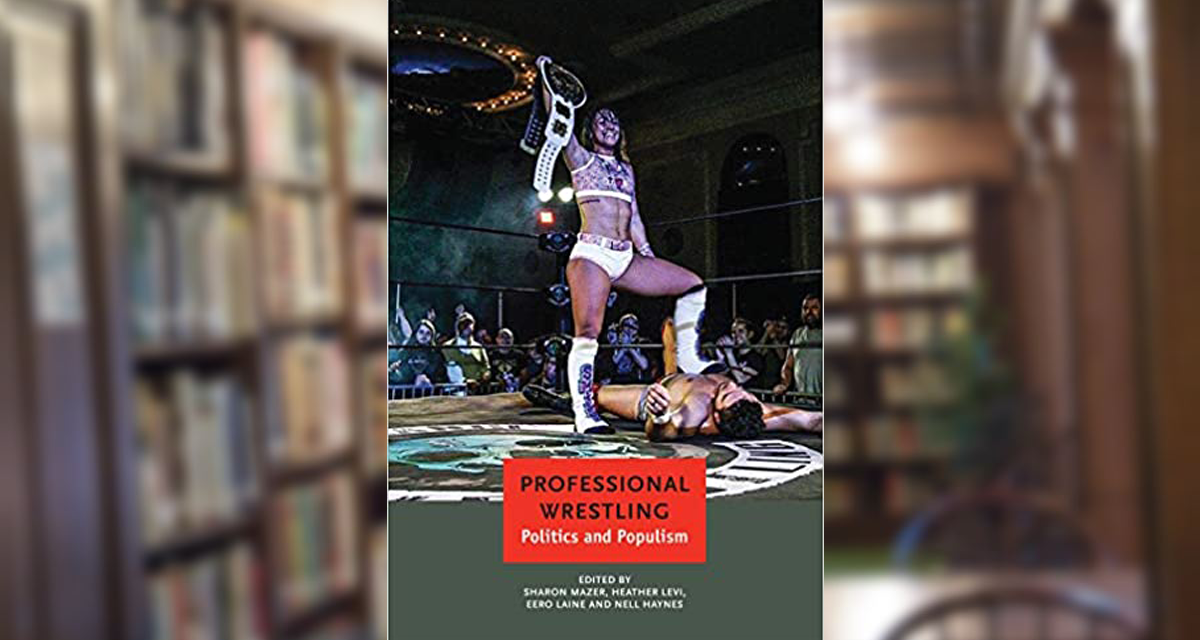Politics and pro wrestling may seem to be strange bedfellows, but they are constantly intertwined, much like barbed wire on the bat of Mick Foley. Just think about it: Former pro wrestler Jesse “The Body” Ventura was the governor of Minnesota. Current Cauliflower Alley Club (CAC) president, B. Brian Blair, was a Hillsborough County Commissioner. Kane (Glenn Jacobs) is currently a mayor in Tennessee. And there’s of course former US President Donald Trump, who hosted WrestleMania 4 and 5 back-to-back, was victorious in the Battle of the Billionaires at WrestleMania 23 and was inducted into the celebrity wing of the World Wrestling Entertainment (WWE) Hall of Fame in 2013.
The connection between politics and pro wrestling is thoroughly dissected and given the academic treatment in the anthology, Professional Wrestling: Politics and Populism edited by Sharon Mazer, Heather Levi, Eero Laine and Nell Haynes and out now from Seagull Books.

Jesse “the Body” Ventura.
“Professional wrestling is a wildly popular form of mass media and live entertainment that makes a spectacle of violent acts,” the editors write in the book’s introduction. “The fight is fixed, the cast of characters is colourful and larger than life, and the battles are waged for social as much as physical supremacy. As a sport, of sorts, professional wrestling is also theatrical without being theatre. With its long history of working contemporary events into storylines and engaging with and commenting upon cultural and military conflicts, professional wrestling is furthermore intrinsically political.”
So, if the above excerpt wasn’t enough of an indication, readers should be aware that this book is very academic. We’re talking university textbook level academic. Thus, this book is not going to appeal to all pro wrestling fans/readers. I’m a reader who firmly believes that academic writing doesn’t have to be heavy and boring. Case in point, I’m a big fan of the intellectual pro wrestling prose of Dr. Jacqui Pratt, Dr. Douglas Edwards and SlamWrestling.net’s own Dr. Nathan Hatton. All three of these writers have the ability to convey complex ideas about wrestling into tangible, accessible and most importantly, memorable reading/learning experiences.
It pains me to say this, as I’ve frequently admitted that I’m someone who loves to learn, but I can’t muster up much enthusiasm for this book. For the majority of this book’s duration, I experienced the unpleasant symptoms of my eyes glazing over, my thoughts wandering and the ever dreaded, “I have no idea what I just read in that chapter, I guess I have to read it again (insert a very sad sigh here).” I’m also a big fan of learning new vocabulary words, but when I had to get out my dictionary over 10 times (yep, I counted) just while reading the introduction of the book alone, I started to get frustrated. (But man, I am truly going to conquer my opponents at my next Scrabble game!) Do you know what demagoguery means? How about heteronormativity? Oh, and it’s totally cheating if you ask any of the good doctors I aforementioned for the answers!
But not wanting to be a total Debbie Downer here, I assure you dear readers, all is not lost. I did find some chapters in this book that intrigued my grey matter:
“Why It Mattered: Wrestling Dramaturgy in the 2016 Presidential Election” by Heather Levi.

Heather Levi.
According to the book’s contributor notes, Levi is an assistant professor of cultural anthropology at Temple University in Philadelphia, an author and has trained in both lucha libre and martial arts. So, first of all, kudos must be given to the editors of this book for finding some highly unique and undoubtedly qualified writers to contribute to this anthology. In this chapter, Levi intriguingly analyses the 2016 US presidential election by categorizing the candidates, Trump and Hillary Clinton, within the wrestling roles of “heel” and “face” respectively. She also expertly explains the “performance conventions that mark each role.”
With Trump being in the role of a pro wrestling heel, Levi points out that Trump was able to utilize the popular heel tactics of whining, attacking partners and antagonizing the public to achieve his victory. Whereas, Clinton was defeated “because she violated the fundamental rule of being a face” which is that “the face can’t turn on the audience,” referring to Clinton missteps such as when she referred to some of Trump’s supporters as “the basket of deplorables” during a campaign fundraiser in New York.
“By campaigning as a wrestling heel, Trump invoked an alternate frame, one which required Clinton to inhabit the role of face,” Levi concluded in the book. “It committed her to a set of conventions that, despite her brief, good-humored appearance in 2008 on the WWE, neither she nor many of her supporters understood, and a role that she wasn’t well positioned to fill. Trump, on the other hand, is a natural heel. His shift of the frame and uncanny suitability for his chosen role set a fraught and dangerous stage for Clinton’s candidacy. With a public perception that the power elite insisted upon her victory, and a long political past spotted by unpopular actions, even at the outset Clinton was not optimally positioned for success in her forced role. Not recognizing the frame shift, the requirements of her role or the attendant dangers, she then made a misstep whose consequences were bewilderingly severe. But examined from the new frame, and with the understanding that she had broken the cardinal rule of being a face, the severe consequences are no longer bewildering at all.”
“Support Your Local Girl Gang: Feminist Resistance in the UK’s Independent Wrestling Scene” by Heather von Bandenburg

Heather von Bandenburg.
I first learned about von Bandenburg when I read and reviewed her incredible memoir, Unladylike: A Grrrl’s Guide to Wrestling, for Slam. Having previously and greedily devoured her book, I was ecstatic to see she was one of the contributors to this book. Along with being an author, von Bandenburg is also an indy wrestler better known to UK pro wrestling fans by her personas Heather Honeybadger and La Rana Venenosa.
When von Bandenburg began her pro wrestling career, she says that she initially envisioned her gimmick as being a “feminist heroine.” But as she writes in her chapter, she quickly learned that “feminism ‘the F-word,’ was literally unspeakable in the hallowed squared circle, for fear of upsetting the men who ran the shows. To be openly feminist was to be ignored backstage by old-school wrestlers (both men and women), to never get pushed higher on the card, to never be taken seriously, to not be booked by many promoters who didn’t like ‘attitudes’ on their wrestlers, and to be subject to constant barbed conversations that opened with men telling me, ‘I don’t hate women or anything, but…’”
von Bandenburg then proceeds to give an insightful overview of women’s involvement in the UK pro wrestling scene. She explores the days of women wrestlers not being allowed to be on the card, the rambunctious older women wrestling fans sitting at ringside (also known as the “Handbag Brigade”), the days where women’s matches “served as a ‘piss break’ for the audience,” the creation of the UK based women’s promotions Bellatrix and Pro Wrestling EVE and the WWE’s claim that it had started a revolution in women’s wrestling. (Spoiler: They really didn’t, but they think they did!) She concludes her chapter by vehemently advising the reader on how they can continue to support the progression of pro wrestling.
“Wradical Wrestling: What Happens When Womxn Run the Ring” by Amy Siegel

Amy Siegel. Photo credit: Yuula Benivolski.
So, I guess the first thing I should address, is no I didn’t incorrectly spell the title to this chapter, that’s how it is written in the book. Secondly, seeing as I already have my dictionary readily available since opening this book, womxn is “an alternative spelling (for the words woman and women) to avoid the suggestion of sexism perceived in the sequences m-a-n and m-e-n, and to be inclusive of trans and nonbinary women.”
Siegel, who is a wrestler, filmmaker and educator, provides readers with a wild, sometimes graphic (there’s a brief mention of menstruation and other female bodily fluids being utilized in the wrestling ring) but absolutely unforgettable look into the ultra-feminist League of Lady Wrestlers (LOLW). The LOLW “was an amateur performance wrestling league” that began in Dawson City, Yukon, in Canada and ran for a duration of five years. Siegel was originally a member of this promotion’s most unique roster and then later “followed as a documentarian and academic.”
Bodily fluids aside, I can’t help but feel I truly missed out by not ever getting to attend a LOLW show in person. With characters including Big Jody Mufferaw (a Paul Bunyan like character), SHREEKA (a swamp witch), Annie Goodfellow (an evangelical preacher), and Anita Pad (“a menstruating hysteric”), this proud feminist/pro wrestling enthusiast would have loved to have reserved a front row seat for every show.
“LOLW’s intervention into the wrestling world was a political act that circumvented traditional dichotomies of good versus evil, slut versus whore, good girl versus bad girl, even female versus male, allowing wrestlers to respond to a sport and a society that seek to reduce their lives and experience to stereotypes,” declared Siegel in the book.
Anyone up for a LOLW revival?

Nell Haynes.
“Cheering the Collective Lucha: Populist Discourse in Bolivian Politics and Wrestling” by Nell Haynes
Haynes is an anthropologist, author and “while researching lucha libre in Bolivia, she trained and performed with (the pro wrestling promotion) Super Catch.” Haynes focuses on the fascinating cholitas luchadoras (Bolivian female pro wrestlers who “don their sparkly layered pollera skirts, sculpt their hair into double braids and climb into the ring.”) As if their ensembles weren’t distinctive on their own, cholitas luchadoras also “connect their wrestling to popular notions of ‘the people’ and struggles for social justice” and of course political unrest in Bolivia.
“Many spectators see the cholita characters as symbolizing their own struggles,” offered Haynes in the book. “The figure of the chola represents the historical exploitation, humiliation, and violence – both physical and emotional – enacted upon working class and Indigenous women in Bolivia.”
EDITOR’S NOTE: If you are someone who is interested in learning more about the cholitas luchadoras, you should also watch the “Powerful Women of Wrestling” episode from the VICE series, The Wrestlers.
“The Money and the Miles” by Larry Degaris

Larry Degaris.
Degaris not only shares some of his vital experiences as a pro wrestler (he was trained by Johnny Rodz) to the final chapter of this book, but after so many overwhelming chapters, he serves as the refreshing and lighter voice us readers need before we literally close the book. Currently a professor of marketing at the University of Indianapolis, Degaris concludes this anthology with frankness, without an ounce of pretentiousness and even constructively critiques some of his fellow contributors to this book. As fellow pro wrestler Carlito would say, “that’s cool!”
“I feel like I learnt life’s most important lessons in pro-wrestling rings, locker rooms and car rides: that often we make things hard on ourselves when we don’t have to; that you get over to the extent someone puts you over; that it’s better to work together towards a common goal than to compete with one another; and that being talented doesn’t mean you’ll get a push,” observed Degaris in a statement that noticeably could be applied to both pro wrestling and politics.
Degaris continues with this analogy throughout the chapter by wittingly discussing concepts including “getting smartened up,” marks, kayfabe, angles, gimmicks and fans that he successfully demonstrates don’t just exist in wrestling, but in the political arenas as well.
“Professional wrestling and modern-day politics share a defining characteristic: they’re both bullshit and pretty much everyone knows it,” offered Degaris.
At the end of this book, I was left thinking of something I constantly tell my son, “If we all liked the same things, the world would be a really boring place to live.” So, while I can’t say I loved this book, there might be some Slam readers who as the late Macho Man Randy Savage would say, “dig it!” Also, I have to admit that I learned something by reading every one of the chapters in the book. And if the chapters I favored aren’t for you, we don’t have to get into the wrestling ring to settle our differences. Instead, you should know that my highlights are just a taste of the subjects covered in this book. The book also takes a deep dive into even more Trump, Brexit, kayfabe, punk politics and even the fan contention over Roman Reigns just to name a few. But if you do decide to give this book a chance, I would highly recommend that you keep your dictionary handy because you’re definitely going to learn some new words. Scrabble, anyone?
RELATED LINKS
- Buy Professional Wrestling: Politics and Populism on Amazon.ca or Amazon.com
- Seagull Books: Website and Twitter
- SlamWrestling Master Book List
- Jesse Ventura story archive
- April 20, 2021: “We shocked the world!” – A look back at wrestlers-turned-politicians
- October 9, 2020: Margolin serves up a second helping of “Trumpmania”
- January 25, 2018: New book turns focus on Trump’s WWE connections
MORE ACADEMIC WRESTLING READING:
- November 16, 2020: Dr. Edwards lays the “smackdown” on philosophy
- October 9, 2019: Lucha Libre Killer makes for captivating reading
- October 22, 2018: Writing about wrestling’s history definitely Tim Hornbaker’s ‘Territory’
- May 11, 2016: Book on prairie wrestling ‘substantive and enlightening’
- April 20, 2014: New book details pre-1900 pioneers of pro wrestling
- November 13, 2013: Quebec history book finally finds a French home
- September 29, 2010: Memphis Wrestling History Presents 1982 is one to add to the collection

